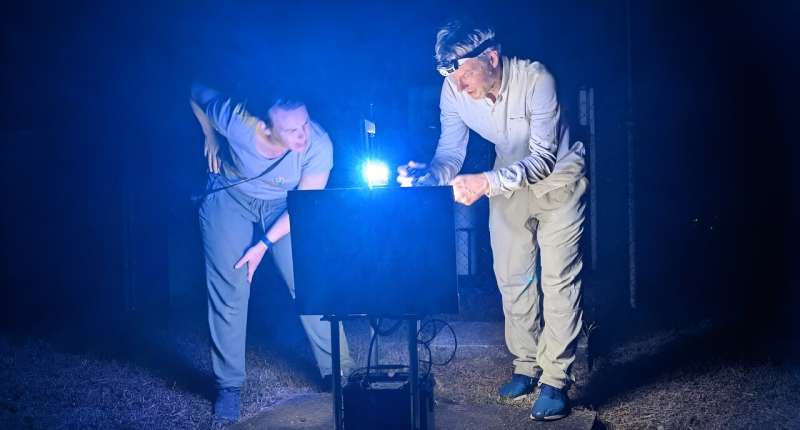This article has been reviewed according to Science X's editorial process and policies. Editors have highlighted the following attributes while ensuring the content's credibility:
fact-checked
peer-reviewed publication
trusted source
proofread
Scientists believe AI will play a crucial role in tackling biodiversity crisis

Scientists say artificial intelligence can transform the identification and monitoring of species across the world, providing a revolutionary tool in supporting action to understand and reverse biodiversity losses.
A shortage of experts means there are major gaps in our understanding of where species occur, how populations are changing and what is causing declines and local extinctions.
There is an acute shortage of data on insects globally, even though they make up four fifths of animal life and are vital for healthy ecosystems and food production.
The UK Center for Ecology & Hydrology (UKCEH) is working with partners across the world to pioneer the use of automated biodiversity monitoring stations.
This partnership is trialing equipment in Europe, North America as well as across the tropics, which are among the most biodiverse places on Earth but where there is significant under-reporting of species.
These solar-powered stations, which can operate autonomously for many months, include high-resolution cameras to photograph insects and acoustic equipment to record the calls of birds and bats.
Scientists then use AI software by training computer systems to recognize species from images and recordings.
While the development of camera systems, recording equipment and AI recognition software is at a relatively early stage, initial trials have been encouraging.
UKCEH and University of Exeter ecologist Professor David Roy explains, "The widespread deployment of automated sensors combined with identification of species using AI can transform our understanding of the impacts of environmental change on wildlife and measure progress towards national and international biodiversity targets.
"This will enable us to identify where biodiversity is under threat, the main drivers of change and to inform solutions to guide local habitat management and address the global biodiversity crisis."
Automated monitoring stations would mean a large amount of long-term, standardized and verifiable data could be generated and processed without labor-intensive field surveys or identification.
There is less variability than in traditional surveys, where traps, locations or observers may be different from one year to the next, and there are less likely to be photographs or recordings to verify the records.
The researchers are developing standardized methods of automated sensing worldwide.
As part of this work, they have published a new study setting out a template for AI-assisted, image-based monitoring of nocturnal insects. The study was published in Philosophical Transactions of the Royal Society B: Biological Sciences
Much of the initial research on automated biodiversity stations is focusing on the monitoring of insects.
These species play crucial roles in ecosystems such as nutrient cycling and food for other creatures, plus support crop production through pollination and natural pest control.
They comprise 80% of all animal life but only 20% of global insect species have been identified, with most assessments largely restricted to butterflies, bees and flies, predominantly from Europe and North America.
Scientists are therefore deploying automated biodiversity monitoring stations not only in these regions but also Argentina, Panama, Costa Rica, Singapore, Japan and Kenya to test their durability in tropical areas.
At present, scientists access images and recordings from a biodiversity monitoring station remotely, and then use computers in their offices to process the data and identify species via AI.
However, UKCEH and The Alan Turing Institute are developing edge processing which will enable images to be analyzed on the device, rather than being downloaded and processed later.
"This will enable non-expert volunteers to use automated systems to produce lots of data about species on many sites, providing a massive step-change in global biodiversity monitoring," says Dr. Oliver Strickson, Senior Research Software Engineer at Turing.
As part of the AgZero+ program, UKCEH is already installing automated camera traps and bioacoustic equipment in UK farms to monitor the presence of insects, birds, amphibians, bats and small mammals. This will assess the effectiveness of UK agri-environment schemes.
More information: D. B. Roy et al, Towards a standardized framework for AI-assisted, image-based monitoring of nocturnal insects, Philosophical Transactions of the Royal Society B: Biological Sciences (2024). DOI: 10.1098/rstb.2023.0108
UKCEH is seeking partners—landowners, food suppliers and industry—to understand how the data and insights from the automated monitoring can be best used to bring about positive change for biodiversity. To get in touch, email solutions@ukceh.ac.uk
Journal information: Philosophical Transactions of the Royal Society B
Provided by University of Exeter




















